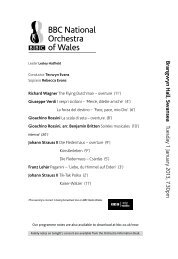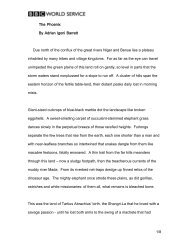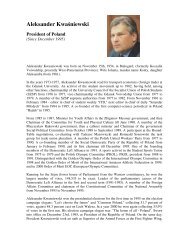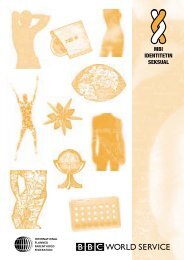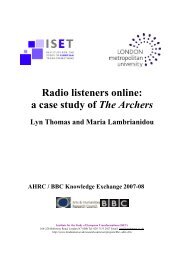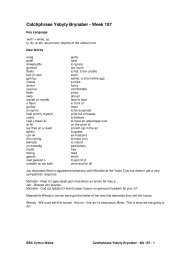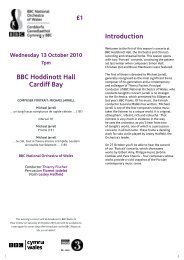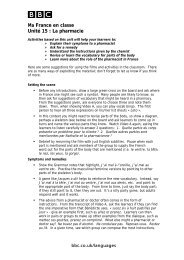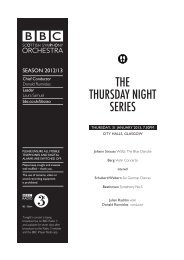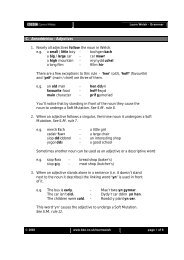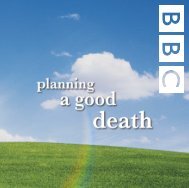musical traditions - BBC
musical traditions - BBC
musical traditions - BBC
You also want an ePaper? Increase the reach of your titles
YUMPU automatically turns print PDFs into web optimized ePapers that Google loves.
B B C Northern Ireland Learning<br />
KS4 music - television<br />
Programme 1 The Pipe Band “All for One”<br />
<strong>musical</strong> <strong>traditions</strong><br />
teacher's notes<br />
Broadcast Dates<br />
Programmes are broadcast on <strong>BBC</strong> 2 in Northern Ireland on Thursday mornings from 10.50 -<br />
11.20am.<br />
Programme Title Broadcast Date<br />
1 The Pipe Band 9 th November<br />
2 The Harp 16 th November<br />
3 The Metrical Psalm 23 rd November<br />
4 The Uilleann Pipes 30 th November<br />
Programme 1 – The Pipe Band<br />
By Samuel Baillie<br />
Learning Objectives:<br />
At the end of the programme pupils will have:<br />
• Developed an awareness of the extent of the pipe band tradition in Northern Ireland and its<br />
strong community links and social function.<br />
• Learned about its separate <strong>musical</strong> sections and the importance of teamwork.<br />
• Become acquainted with Piobaireachd (Pibroch – pronounced “pibrock”), the ancient music<br />
of the Scottish Highland Bagpipe.<br />
• Gained an understanding of the complexities of the structure and tuning of the instrument.<br />
About the Programme<br />
This programme provides us with a close and personal view of the complexities and commitment<br />
of what it is like to be involved in pipe bands. The main thrust is the competitive edge of playing<br />
in bands and the importance of working as a team. The development of pipe bands and their<br />
contribution to the social fabric of local communities is illustrated but this is set beside the need<br />
for highly developed technical skill and a full understanding of the component parts of the bagpipe<br />
as an instrument, which is essential to obtain good sound. People on the programme emphasise<br />
this aspect of their enjoyment of pipe bands and appear to relish the challenge of getting it “just<br />
right” for the moment of performance. Complex factors such as the weather, types of reeds and<br />
bags used, as well as individual blowing styles, are all taken into account in order to produce each<br />
band’s own unique sound.<br />
People express their deep feelings of excitement when they are involved in what is seen as a good<br />
performance, particularly as this is the climax to hours of practice and preparation. Whilst pipe<br />
band competitions as such may be seen by the participants to be like a sport, it is clear that this<br />
www.bbc.co.uk/ni/schools 1
B B C Northern Ireland Learning <strong>musical</strong> <strong>traditions</strong> The Pipe Band<br />
teacher's notes<br />
refers only to the actual competition itself. The content of the performance is the highly developed<br />
art form, taking years to achieve competition standard and therefore demanding a high degree of<br />
commitment.<br />
Background<br />
Pipe bands may be seen as a relatively new phenomenon as distinct from the bagpipe itself<br />
(which has no clear origin, being found in countries throughout the world for thousands of years)<br />
and perhaps not particularly Scottish, having developed from the formation of army bands around<br />
the end of the 18 th century. At that time the British Army boasted twenty-two pipe bands made up<br />
from eleven Highland Regiments, one from each of their home and away battalions. Two centuries<br />
later, whilst the regiments might have changed somewhat, the number of bands within the British<br />
Army had remained almost constant.<br />
There was a time when the Scottish bagpipe and its music might have been lost forever. After the<br />
defeat of the Jacobite army at Culloden in 1745 and the passing of the Disarming Act of 1747, the<br />
bagpipe, though not mentioned in the Act, was treated as an instrument of war and was therefore<br />
forbidden along with weapons and Highland Dress. The Act was repealed in 1782, probably to<br />
allow the raising of Scottish regiments.<br />
The Þ rst Highland Regiment to be raised was in 1757 and in 1854 the Þ fes of the English<br />
regiments were replaced by the pipes of the Highland regiments. Even to-day the army refers to<br />
these pipe bands as “pipes and drums”.<br />
The Scottish bagpipe, however, was not originally intended to be used as a group instrument<br />
and has been preserved in its present form, not by bands, but by a type of music known as<br />
piobaireachd (pronounced “pibrock”), simply meaning “pipe playing”, or Ceol Mor (the big music),<br />
dating back to the 15 th century. Its origin is obscure, but it is associated with the legendary<br />
piping family of the MacCrimmon’s who are said to have run a piping school at Boreraig on the<br />
island of Skye until 1773. The MacCrimmon’s were the hereditary pipers of the MacLeod’s of<br />
Dunvegan who lived in Dunvegan Castle and in 1967, Dame Flora MacLeod instituted the Annual<br />
MacCrimmon Memorial Piobaireachd Competition at Dunvegan Castle. The trophy is a silver<br />
chanter and the competition is open only to winners of the highest piping awards.<br />
After the repeal of the Disarming Act the Highland Society in London held an annual bagpipe<br />
competition. In 1784 the competition was transferred to Edinburgh and from 1785, as now,<br />
competitors were required to wear Highland Dress.<br />
Piping competitions were solely for the playing of piobaireachd and it was not until 1859 that prizes<br />
for strathspey and reel playing (Ceol Beag – little music) were introduced in the Northern Meeting<br />
in Inverness. Marches, that is, pipe tunes for marching, originally referred to as quicksteps, were<br />
introduced at around the same time. Angus MacKay (1813 -1859), Queen Victoria’s Þ rst piper, is<br />
credited with introducing the competition type march and he left a collection of piobaireachd in<br />
both staff notation and in canntaireachd (pronounced - canterrock).<br />
www.bbc.co.uk/ni/schools 2
B B C Northern Ireland Learning <strong>musical</strong> <strong>traditions</strong> The Pipe Band<br />
teacher's notes<br />
Until the late 18 th or early 19 th century, pipe music had been transmitted from player to player by<br />
canntaireachd, which is a form of singing where each note is represented by a different vowel<br />
and embellishments are represented by consonants. This form of teaching is regarded, even today,<br />
as the proper way to learn piobaireachd, but the move towards staff notation was probably<br />
necessitated by the inevitable acceptance of Ceol Beag as a legitimate form of pipe playing.<br />
The MacCrimmon tradition disapproved of the playing of light music and it was forbidden in their<br />
school, probably because it could be played on other instruments and was not therefore, strictly<br />
speaking, pipe music. Nevertheless, by the mid 18 th century, reels and jigs had become an integral<br />
part of pipe playing. The Highland Society believed that strathspey, reel and jig playing helped<br />
in the Þ ngering of piobaireachd. Clearly this could have been a face-saving way of allowing their<br />
introduction into competitions.<br />
In 1903 the Piobaireachd Society was formed to preserve the music which itself had preserved the<br />
instrument. It established a piping school at Edinburgh Castle in 1910 which was taken over by the<br />
army in 1959. The debt owed to the army for the development of light music, particularly marches,<br />
which provides the repertoire for pipe bands is widely acknowledged, as is its support for the<br />
preservation of piobaireachd, a form of music not usually associated with band performances.<br />
The Scottish Pipe Band Association came into existence in 1930 and in 1980 was granted the title<br />
of The Royal Pipe Band Association. This is now a world wide organisation responsible for a range<br />
of competitions including the World Pipe Band Championship. The Þ rst pipe band competition<br />
on record took place in 1905, but the World Championship was only instituted in 1947, after the<br />
Second World War.<br />
This popular interest has had the effect of lessening the interest in piobaireachd, the very reason<br />
for the Highland bagpipe being extant. The attraction for most pipers lies in the competition type<br />
tunes, but recently there has been a resurging interest in piobaireachd and also in canntaireachd.<br />
Band competition tends to focus on well tuned pipes, the absence of errors and an integrated band<br />
performance between pipes and drums. Drumming has now become a highly technical art, having<br />
moved from providing a tempo and basic rhythm to following the melody, but now contributing to<br />
the overall performance as a group instrument in its own right, giving extra drive and excitement.<br />
The structure of the drum has altered to accommodate this change. Rope tensioned drums have<br />
been replaced by screw tensioned instruments with tighter heads, snares have been added to<br />
both top and bottom heads to provide a brighter and sharper sound and the shell of the drum has<br />
been redesigned to facilitate greater tensioning of the head. All of these were needed to allow the<br />
playing of an increasing number of strokes per bar and it is quite difÞ cult to pick out single strokes<br />
in modern pipe band drumming.<br />
Developments have also been evident in materials used in the manufacture of bagpipes, with<br />
synthetic bags and plastic drone reeds being introduced to counteract the effect of moisture from<br />
the atmosphere and differences in blowing but the basic chanter reed remains unchanged. Reeds<br />
are made from cane and chanter reeds are “double vibrators” like an oboe reed but drone reeds<br />
are “single vibrators” such as a clarinet. The difference is that pipe reeds are blown through reed<br />
www.bbc.co.uk/ni/schools 3
B B C Northern Ireland Learning <strong>musical</strong> <strong>traditions</strong> The Pipe Band<br />
teacher's notes<br />
chambers with the use of an air bag where the reeds do not come into contact with the mouth of<br />
the player as in other reed instruments. This necessitates the skill of blowing evenly to maintain<br />
a steady sound as the player has to ensure that four reeds (chanter and three drones) are kept<br />
sounding at constant pressure.<br />
Pipers thus learn their melodies on a “practice chanter” without drones or airbag and progress<br />
to the full pipe when this has been accomplished. In effect this means the mastering of two<br />
instruments rather than just one. The tuning of drones is accomplished by altering the length of<br />
the drone which is made in sections for this purpose. Drones are made up of one bass drone<br />
and two tenor drones, with the bass drone being an octave lower than the tenor drone, therefore<br />
being twice the length. All the drones are tuned to the fundamental note on the chanter which is<br />
an octave higher than the tenor drones. This is called “A” on the pipes but in pitch is just slightly<br />
sharper than B ß at on the piano, maintaining a “pedal” note, that is, a sustained single note lower<br />
than the melody. As the melody moves about on the chanter the harmonics of the drones allows<br />
an internal harmony to be heard. Traditionally the drones were tuned by ear but now electronic<br />
tuners are often employed.<br />
There is no doubt about the appeal of the sound of the pipes to some and its offence to the ear to<br />
others. The pipe is very rich in harmonics, with a limited range of notes and does not produce a<br />
diatonic scale. This does not make it any less <strong>musical</strong>, only <strong>musical</strong>ly different, which others Þ nd<br />
attractive and exciting. It remains the case that the playing of the Scottish bagpipe and pipe bands<br />
is growing in popularity throughout the world and across cultures, demonstrating the power of<br />
music and art to unite people from disparate backgrounds.<br />
Resources:<br />
• CDs<br />
World Pipe Band Championships 2004 (3 volumes)<br />
Qualifying Heat CD MON 858<br />
CD MON 859<br />
CD MON 860<br />
Available from retail outlets.<br />
Piobaireachd & Canntaireachd<br />
“Whispers of the Past”<br />
Vol 1 Piobaireachd and Canntaireachd<br />
Vol 2 The Harmonic Piobaireachd<br />
Available from:<br />
The Northern Ireland Pipe and Drumming School<br />
38 Railway Street<br />
Lisburn BT28 1XP<br />
Tel. 028 9262 8591<br />
www.bbc.co.uk/ni/schools 4
B B C Northern Ireland Learning <strong>musical</strong> <strong>traditions</strong> The Pipe Band<br />
• Publications<br />
Roderick D Cannon 1988 (Reprinted 1990). The Highland Bagpipe and its Music, John<br />
Donald Publishers Ltd. Edinburgh. ISBN 0-85976-153-3<br />
William Donaldson 2000. The Highland Pipe and Scottish Society, Tuckwell Press, East<br />
Lothian, Scotland. ISBN 1-86232-075-6<br />
Classroom Activities:<br />
How do players know when to start?<br />
Listen to a pipe band starting to play and identify how each player knows when to begin playing.<br />
Identify different drums<br />
Watch a pipe band playing and pick out three types of drums which look different and are played<br />
differently.<br />
Count the different sound sources that come from a pipe<br />
Look at a piper playing and count the number of different sources of sound coming from the<br />
instrument.<br />
How do you tune a drone?<br />
Watch drones being tuned and decide how this is done.<br />
Pick a favourite instrument<br />
Which instrument, pipes or drums, do you Þ nd most exciting? Give a reason for your preference.<br />
Questions For Discussion After the Programme:<br />
Tuning<br />
Why is tuning a pipe band so difÞ cult?<br />
Teamwork<br />
teacher's notes<br />
What makes a band an example of good teamwork?<br />
www.bbc.co.uk/ni/schools 5
B B C Northern Ireland Learning <strong>musical</strong> <strong>traditions</strong> The Pipe Band<br />
Classical Music<br />
What is known as the classical music of the pipes?<br />
Pipe band competitions<br />
Would you consider pipe band competitions as art or sport?<br />
Local pipe bands<br />
Do you know of any pipe bands in the area where you live?<br />
Pipe band appeal<br />
teacher's notes<br />
What do you think makes being in pipe bands attractive to many people?<br />
www.bbc.co.uk/ni/schools 6



